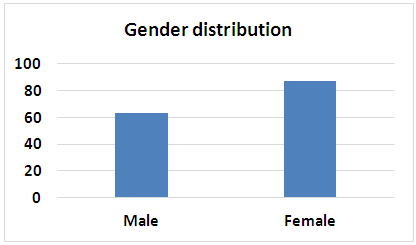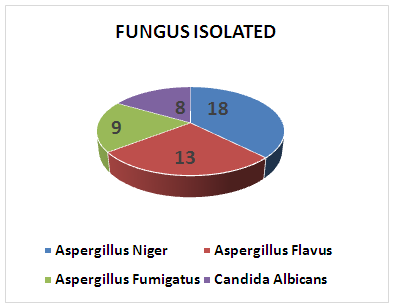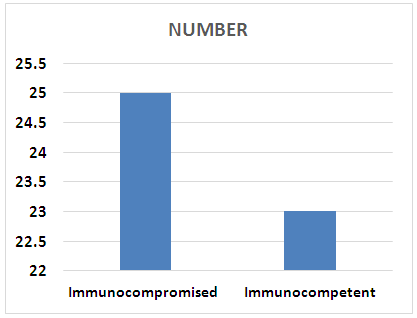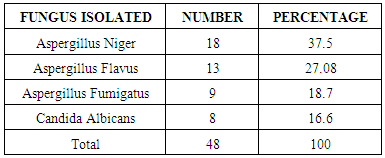-
Paper Information
- Paper Submission
-
Journal Information
- About This Journal
- Editorial Board
- Current Issue
- Archive
- Author Guidelines
- Contact Us
Research in Otolaryngology
p-ISSN: 2326-1307 e-ISSN: 2326-1323
2018; 7(1): 5-8
doi:10.5923/j.otolaryn.20180701.02

Fungal Flora in Chronic Suppurative Otitis Media: A Prospective Study in a Tertiary Care Hospital
Shashikala BS, Deepthi P., Viswanatha B.
Otorhinolaryngology Department, Bangalore Medical College & Research Institute, Bangalore, India
Correspondence to: Viswanatha B., Otorhinolaryngology Department, Bangalore Medical College & Research Institute, Bangalore, India.
| Email: |  |
Copyright © 2018 Scientific & Academic Publishing. All Rights Reserved.
This work is licensed under the Creative Commons Attribution International License (CC BY).
http://creativecommons.org/licenses/by/4.0/

Chronic suppurative otitis media is a persistent disease of the middle ear, capable of causing severe destruction and irreversible sequel. There has been a recent increase in the incidence of fungal flora in these infections due to excessive use of broad spectrum antibiotics, antibiotic ear drops and corticosteroids. Diagnosis and management of fungal infection can be challenging in immunocompromised patients. Materials and methods: A prospective study was conducted over a study period of two years. A total number of 150 ear swabs were investigated for the present study. Their gram staining, direct microscopy with KOH, culture sensitivity, and biochemical tests were carried out to identify the organisms. All the swabs were collected from patients with clinical diagnosis of chronic suppurative otitis media visiting otolaryngology outpatient department of tertiary care hospital. Results: Out of 150 swabs, fungal culture was positive in 48 cases (32%). Of them on cultures, Aspergillus was isolated in 40 cases and Candida in 8 cases. 52.08% (25 of 48) of the cases with fungal infection of the ear were immunocompromised. Conclusion: Diagnosis of fungal infection of the ear requires maintaining a high index of suspicion. Fungal culture should be obtained in all patients with persistent otorrhea in spite of adequate antibiotic therapy.
Keywords: Fungal flora, Chronic suppurative otitis media
Cite this paper: Shashikala BS, Deepthi P., Viswanatha B., Fungal Flora in Chronic Suppurative Otitis Media: A Prospective Study in a Tertiary Care Hospital, Research in Otolaryngology, Vol. 7 No. 1, 2018, pp. 5-8. doi: 10.5923/j.otolaryn.20180701.02.
1. Introduction
- Chronic suppurative otitis media is a long standing disease of the middle ear cleft. It is a chronic inflammatory process in the middle ear space that results in long term or permanent changes in the tympanic membrane including atelectasis, dimeric membrane formation, perforation, tympanosclerosis, retraction pocket or cholesteatoma [1]. In developing countries, chronic suppurative otitis media is one of the most common ear diseases encountered in routine clinical practice. The burden of chronic suppurative otitis media in the developing countries is very high, amounting up to 72 cases per 1000 inhabitants [2]. Certain cases of safe type of chronic suppurative otitis media keep discharging, in spite of adequate topical and systemic antibiotics. Sen Gupta et al [3] proposed that this intractable otorrhea occurs due to superimposed fungal infections over chronic otitis media. Otomycosis is sporadic and caused by a wide variety of fungi, most of which are saprobe occurring in diverse type of environmental material. The most common fungi found in chronic suppurative otitis media are Aspergillus and Candida. The warm and moist environment of the ear favor their growth [4]. Common symptoms of otomycosis are itching, ear pain, ear discharge, blocked sensation, decreased hearing and tinnitus.In the recent years there has been an increase in the incidence of fungal infections of the ear, as a result of increase in immunocompromised patients. An immunocompromised host is more susceptible to otomycosis. Patients suffering from diabetes, lymphoma, transplantation patients, patient receiving chemotherapy or radiation therapy and AIDS patients, are also at increased risk for potential complications from otomycosis. Adequate data on the exact prevalence of fungal infection superimposed with chronic suppurative otitis media is lacking. Hence, this study was conducted to determine the incidence of fungal infection and the pattern of flora noted among the patients with chronic suppurative otitis media who attended the ENT department of tertiary care hospital.
2. Materials and Methods
- The present study was conducted among patients with chronic suppurative otitis media who attended outpatient department of a tertiary care institute for a period of 2 year from July 2015 to June 2017. A total of 150 cases were included in the study. Detailed history regarding present illness and regarding any underlying co morbidities were noted, otological and systemic examination were conducted. Ear discharge were collected using sterile swab sticks which were labeled and sent to the laboratory for fungal culture studies.Direct smear examination: A small amount of material was spread of a glass slide with 10% KOH using an inoculating loop, the smear was examined for the presence of epithelial cells, pus cells, yeast cells, pseudohyphae and hyphae. Culture for fungus: Ear discharge from aural swabs was inoculated into a tube of Sabouraud’s Dextrose Agar, with chloramphenicol without cycloheximide (actidione). The culture tube kept at 22°C for 2-4 weeks. Isolate was identified from colony characters, macroscopic and microscopic examination was done to identify fungus. In the case of yeast, germ tube fermentation test was done for identification of Candida Albicans.
3. Results
- Total of 150 cases were included in the study, of whom 63(42%) were male and 87(58%) were female [Table 1 & Graph 1].
|
 | Graph 1. Showing gender distribution of the patients |
|
 | Graph 2. Showing various fungal strains isolated |
|
 | Graph 3. Showing immunological status of patients with fungal infection |
4. Discussion
- Otomycosis is the fungal infection of the external ear, middle ear and open mastoid cavity [5]. Although this disease is rarely life threatening, it can present as a challenging and frustrating situation to the patient and the otolaryngologist due to long term treatment and high rate of recurrence [6]. Mycological analysis of 150 cases revealed that 48 cases (32%) were of fungal origin. However, significantly lower figures were noted in studies by Baruah et al [7] (17.48%) and Sen Gupta et al [3] (25%). In another study, fungal etiology was found in 15% of cases, out of which 60% were Candida species and 40% were Aspergillus species [8]. It has been postulated by Kunelskyavavya et al [9] that prolonged use of broad spectrum topical antibiotics lead to suppression of bacterial flora and subsequent emergence of opportunistic fungal flora in the oral cavity and gastrointestinal tract. Likewise in the middle ear, fungal infection supervenes due to prolonged use of topical antibiotics.In a study from Nigeria on 569 patients of otitis media, fungi isolated were Aspergillus niger (9.2%) followed by Candida albicans (5.4%) [10]. In the study by Jaiswal et al [11], in the sensivity test conducted, Amphotericin was found to be mildly sensitive against various fungal cultures. Clotrimazole and miconazole were found to be moderately effective against Candida and Aspergillus species. General cellular immunity is reduced in situations such as diabetes, steroid administration, HIV infection, chemotherapy and malignancy (especially those involving cells of immune system). This makes an immunocompromised host susceptible to fungal infections. Normal bacterial flora is one of the host defense mechanism against fungal infections [12]. This mechanism is altered in patients using antibiotics ear drops and cause otomycosis. An immunocompromised host is more susceptible to otomycosis. Patients suffering from diabetes, lymphoma, transplantation patients, patient receiving chemotherapy or radiation therapy and AIDS patients, are also at increased risk for potential complications from otomycosis [13]. The complications include hearing loss and invasive temporal bone infection. Treatment of otomycosis includes microscopic suction clearance of fungal mass, discontinuation of topical antibiotics and treatment with antifungal ear drops for three weeks. Ear should be kept dry for three weeks [14].Diagnosis and management of associated fungal infections in chronic suppurative otitis media can be really challenging in immunocompromised patients. Recurrences are more common in immunocompromised patients than in immunocompetent patients. Eradication the disease may be difficult in immunocompromised patients, who have undergone canal wall down mastoidectomy for attico antral ear disease. In these patient prolonged antifungal therapy is required [15].
5. Conclusions
- The present study suggests that regular laboratory tests with deliberate search for fungi are desirable in all cases of chronic suppurative otitis media. Otologist should remain alert for associated fungal infections in patients with chronic suppurative otitis, which are refractory to treatment with antibiotics. An otolaryngologist should consider obtaining hematological investigations and fungal cultures when this disease is suspected in immunocompromised, host which are not responding to routine antibiotic therapy.
 Abstract
Abstract Reference
Reference Full-Text PDF
Full-Text PDF Full-text HTML
Full-text HTML

